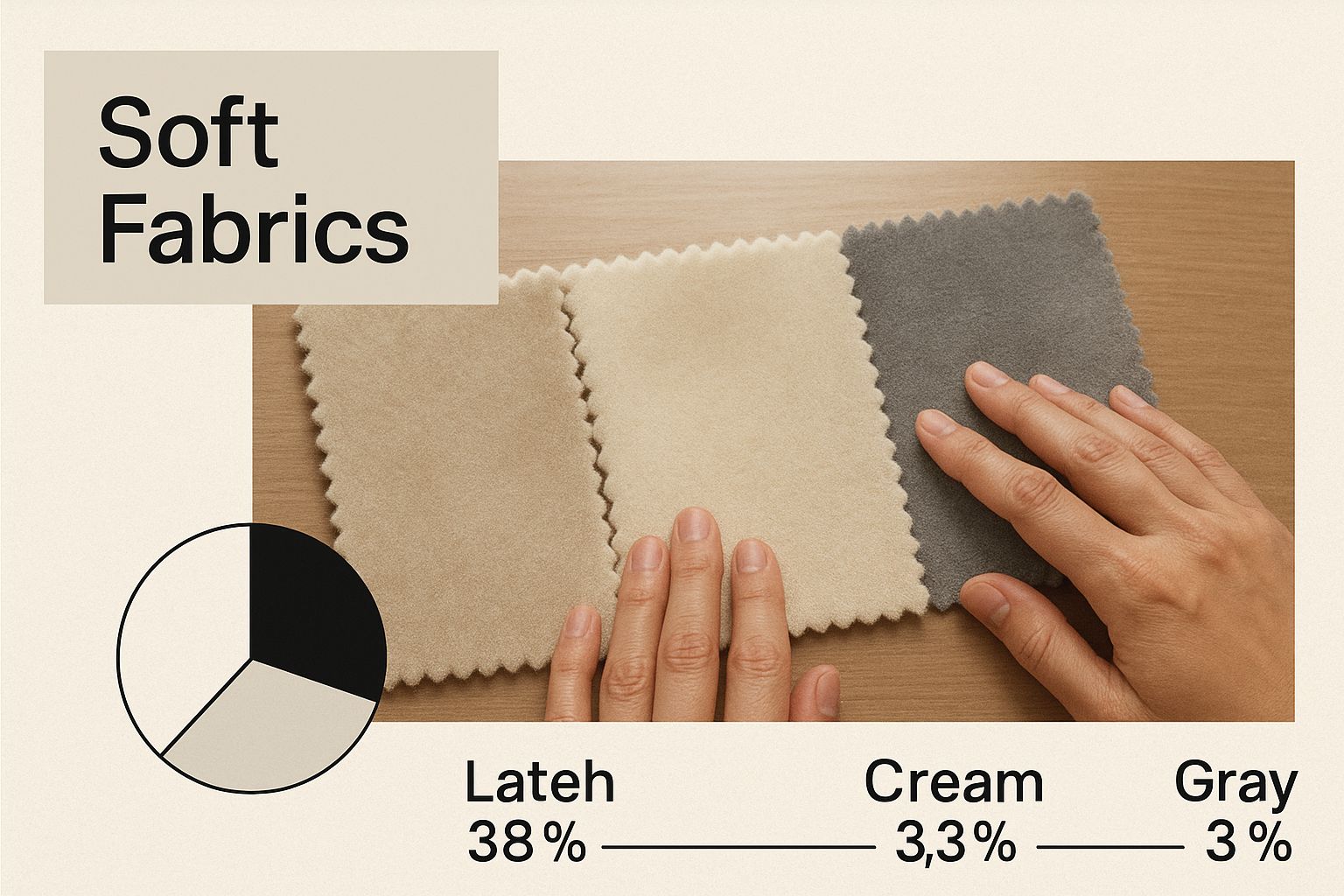When the nights start drawing in and there’s a distinct chill in the air, nothing quite compares to the feeling of snuggling into a truly warm and inviting bed. The right warm duvet cover is often the unsung hero of a cosy bedroom, turning your bed into a sanctuary for a perfect night's sleep.
Your Guide to the Perfect Warm Duvet Cover

Consider this your personal guide to finding that perfect duvet cover. We will walk you through everything that matters, from the materials that are best at trapping heat to the way different fabric weaves influence how they feel against your skin. After all, a duvet cover is not just a protective sleeve for your duvet, it is a crucial part of your bed's insulation and the layer you feel all night long.
Why Your Duvet Cover Matters
Choosing a duvet cover is about so much more than picking a colour or pattern that matches your decor. The material itself makes a world of difference to how warm and comfortable you feel. For instance, some fabrics are fantastic at trapping tiny pockets of air, which creates a natural thermal barrier that holds onto your body heat.
Other equally stylish materials are designed for maximum breathability, which is great for summer but less so on a frosty winter night. Getting to grips with this fundamental difference is the first step towards building your ideal winter bed. If you would like to brush up on the essentials, you can find out more in our detailed guide on what duvet covers are and how they work.
What You Will Learn
Our aim is simple: to help you find a cover that not only looks beautiful but also delivers that all important warmth and comfort on a cold British night. We will break down the key things to look for, making your choice a whole lot easier.
- The best materials for warmth, such as brushed cotton flannel and super soft fleece.
- How construction affects feel, including what thread count and weave really mean for cosiness.
- Styling tips to make your bedroom look and feel as warm as it is.
- Simple care instructions to keep your warm bedding feeling soft and new for years to come.
By the time you have finished reading, you will have everything you need to confidently choose the perfect warm duvet cover and create your ultimate sleep sanctuary this winter.
What Actually Makes a Duvet Cover Warm?
Ever wondered what the secret is to a duvet cover that feels instantly warm and keeps you snug all night? It really boils down to two key things: the material it is made from and how that material is put together. Some fabrics are just brilliant natural insulators, creating tiny pockets of air that trap your body heat and keep the chill at bay.
Think of it like choosing a winter coat. A brushed cotton flannelette is your cosy fleece jacket, soft and warm the moment you slip it on. A heavier, more tightly woven cotton, on the other hand, is like a classic wool peacoat, offering a more substantial, dense layer of insulation. This is precisely why some duvet covers feel so welcoming from the second you get into bed.
The Role of Material and Weave
The material is, without a doubt, the most important factor. Natural fibres like cotton can be transformed through various manufacturing techniques to boost their insulating power. For instance, when cotton is brushed, the surface fibres are gently raised. This process creates that famously soft, fuzzy texture that is so good at trapping warm air.
This infographic highlights some of the best fabric options for creating an inviting and warm bed.

As you can see, textures like plush fleece and brushed cotton excel at delivering that immediate feeling of warmth and comfort. Getting to grips with how these textures work is the first step towards choosing the perfect cover for you.
This growing appetite for cosier bedding is part of a bigger picture. The UK bed linen market was valued at around £1.43 billion and is projected to grow by roughly 5.9% each year until 2035. This trend points to a clear demand for more luxurious and comfortable home comforts, especially warm duvet covers.
Comparing Popular Warm Duvet Cover Materials
To make things a bit clearer, here is a quick rundown of the most common materials you will find for warm duvet covers. Each has a unique feel and offers different benefits for a cosy night's sleep.
| Material | Best For | Feel |
|---|---|---|
| Brushed Cotton | Instant warmth and a super soft, lived in feel from day one. | Fuzzy, slightly fluffy, and incredibly gentle on the skin. |
| Fleece | Maximum cosiness, ideal for the coldest nights and those who really feel the cold. | Plush, thick, and velvety, similar to a favourite soft blanket. |
| Flannelette | A classic winter choice that is breathable yet exceptionally warm. | A soft, napped texture that is lightweight but provides excellent insulation. |
| Heavyweight Linen | Natural temperature regulation with a satisfying, weighty feel. | Substantial and textured, it softens beautifully with every wash. |
Ultimately, the right choice comes down to personal preference. Whether you love the instant hug of a fleece or the breathable warmth of a quality flannelette, understanding the material is key.
Trapping Heat for All Night Comfort
A duvet cover's ability to keep you warm is all about its power to trap air. The more still air a fabric can hold within its fibres, the better it will be at insulating you from the cooler air in your bedroom.
The most effective warm duvet covers work by creating a microclimate around your body. They do not generate heat themselves, but they are exceptionally good at holding onto the heat you naturally produce, keeping you comfortable all night long.
This simple principle is why a fluffy fleece or a thick flannelette feels so much warmer than a smooth, crisp cotton percale. The raised fibres create a deeper pile with much more space for air to get trapped. To learn more about the complete system, check out our guide on how duvets and their covers work together. By choosing the right material, you are essentially picking the best possible barrier against the cold.
The Best Materials for Winter Bedding
Choosing the right material is easily the most critical step in finding the perfect warm duvet cover. The fabric you settle on will dictate everything, how the bedding feels against your skin, how well it traps heat, and ultimately, how it fits into your life. Let's dive into the top contenders for creating that wonderfully snug and inviting bed on a chilly winter evening.
Each material brings something different to the table, from the instant softness of brushed cotton to the cloud like embrace of a teddy fleece. It is this variety that explains why the global duvet cover market, valued at around USD 5.23 billion, keeps expanding, with a particular demand in the UK for cosy yet stylish options. We are all searching for fabrics that promise a better, warmer night's sleep. If you are curious, you can explore the full research on the duvet covers market.
Brushed Cotton for a Gentle Warmth
Brushed cotton, which you might know as flannelette here in the UK, is a winter classic for a very good reason. It starts life as standard cotton, but the surface is gently brushed to raise the fibres. This simple but clever process creates a beautifully soft, slightly fuzzy texture that feels warm the moment you touch it.
This material is fantastic at trapping a thin layer of air, which acts as a natural insulator against the cold. But unlike some synthetic fabrics, brushed cotton remains breathable. That is a huge plus, as it helps regulate your temperature and stops you from feeling stuffy during the night.
- Best for: Anyone after a traditional, soft, and breathable warm duvet cover.
- Feel: Velvety soft, lightweight, and incredibly gentle against the skin.
- Care: It washes well, but it is best to use a gentle cycle to keep those fibres smooth and minimise any pilling over time.
Fleece and Teddy Fleece for Maximum Cosiness
If your main goal is to feel as snug as a bug, then fleece or teddy fleece is the ultimate choice. These synthetic fabrics are engineered specifically for maximum warmth, boasting a deep, plush pile you can really sink into. Teddy fleece, with its longer, fluffier fibres, genuinely mimics the texture of a soft toy, offering an unmatched level of cuddly comfort.

These warm duvet covers are insulation powerhouses, perfect for anyone who really feels the cold or for keeping children’s beds extra toasty. They provide an immediate sense of warmth, so there is no chilly shock when you first climb into bed.
A great duvet cover material should feel like a welcome hug at the end of a long day. Fleece and teddy fleece are brilliant at providing that comforting, enveloping feeling that makes you want to curl up and stay in bed.
Because they are made from synthetic fibres, they are also very durable and easy to look after, often drying impressively quickly after washing. The trade off? While fleece is exceptionally warm, it is not as breathable as natural fibres like cotton. This is something to bear in mind if you are prone to overheating while you sleep. To better understand how different fabrics suit various needs, have a look at our detailed guide on the best materials for bed sheets.
How Fabric Weave and Thread Count Affect Warmth
It is not just about the material you choose, how that material is actually put together makes a massive difference to how warm your duvet cover will feel. The construction of the fabric, specifically its weave and thread count, are the details that separate a decent duvet cover from one that is truly exceptional for those chilly nights.
Lots of people assume that a higher thread count automatically equals a warmer bed, but it is a bit more nuanced than that. Thread count is simply the total number of threads woven into a single square inch of fabric. When you see a higher number, like 400 or more, it means the threads are packed together very closely, creating a much denser, less breathable material.
That density is what we are interested in. A tighter fabric has fewer microscopic gaps for air to escape, meaning it is far better at trapping your body heat. It acts as a more effective barrier against the cold air in your bedroom. While it is not the only thing that matters, a denser weave definitely contributes to a cosier feel. If you are curious to learn more, our guide explains everything about finding the best thread count for your sheets.
Weave Makes a Real Difference
The weave, the specific pattern used to interlace the threads, also has a huge say in the fabric’s final feel and warmth. You do not need to become a textile expert, but getting to grips with two of the most common weaves will help you choose wisely.
-
Percale Weave: This is a straightforward, grid like pattern: one thread over, one thread under. The result is a fabric that feels light, crisp, and incredibly breathable. It is fantastic for hot sleepers or for staying cool in the summer.
-
Sateen Weave: This weave follows a different structure, usually four threads over and one under. This technique exposes more threads on the surface, creating a fabric that is noticeably silkier, smoother, and drapes beautifully with a subtle lustre.
When you are looking for a warm duvet cover, sateen is almost always the superior choice. Its tighter, denser construction is inherently less breathable than percale, which means it is much better at trapping heat and keeping you insulated all night long.
Think of it like this: a percale weave is like a light linen shirt, perfect for letting the breeze through. A sateen weave is more like a tightly woven jacket, designed to keep the chill out.
By looking at both the thread count and the weave, you get a much clearer picture of how a duvet cover will actually perform. These details let you move beyond just the colour or fibre type and pick a cover that is genuinely engineered for a cosy, restorative sleep.
How to Style Your Bedroom for a Cosy Feel
A warm duvet cover is not just a practical bit of bedding, it is the heart of your bedroom’s look and feel. The right styling can turn your room from just a place to sleep into a genuine sanctuary, a space that looks every bit as cosy as it feels. The real secret lies in playing with colours and textures that whisper warmth and calm.
Your colour palette has an immediate impact on how snug a room feels. Deep, rich shades are fantastic for this. Think about a warm duvet cover in a forest green, a moody navy blue, or even a warm berry red. These enveloping colours tend to absorb light, which makes your bedroom feel more intimate and peaceful, perfect for hibernating on a dark winter evening.
Layering for Looks and Warmth
Once you have settled on your main colour, the real fun starts with layering. Piling on different textures does not just make your bed look more interesting, it adds genuine layers of insulation. It is a simple, effective trick that makes your bed look utterly irresistible.
Think of your warm duvet cover as the foundation and build up from there. Here are a few ideas to get you started:
- Add a Chunky Knit Throw: A thick, knitted blanket draped casually across the foot of the bed adds a wonderfully tactile element. It is also right there when you need to pull up an extra layer on a truly cold night.
- Introduce a Quilt: A classic quilt can bring a touch of traditional charm and another light layer of warmth without feeling too heavy or bulky.
- Play with Cushions: Do not be afraid to mix and match cushions of different sizes, shapes, and fabrics. A soft velvet cushion next to a fluffy faux fur one, for instance, adds real depth and a touch of luxury.
Choosing Premium Textures
Investing in high quality materials is a growing trend. It is no surprise that the UK luxury bedding market is expanding, with projections suggesting it will reach USD 135 million by 2032. This shift is all about people wanting to invest in lasting home comforts, like duvet covers made from high end cotton, silk, or even cashmere blends renowned for their exceptional warmth. You can explore more about the rising demand for luxury bedding and what is driving this trend.
The goal is to create a bed that you cannot wait to climb into. Layering different textures like soft fleece, smooth cotton, and plush velvet makes your bed a feast for the senses, enhancing the overall feeling of comfort and retreat.
By carefully choosing your colours and textures, your warm duvet cover becomes the focal point of a stylish and restful winter haven. It is all about creating a space that feels like a warm hug the moment you walk through the door.
Keeping Your Warm Duvet Covers Soft and Cosy
When you have found the perfect warm duvet cover, you want that soft, inviting feeling to last for many winters to come. The good news is, a little bit of care goes a long way in protecting your investment and making sure it is ready for you the moment the temperature drops.
Materials like brushed cotton flannelette and fluffy teddy fleece have their own unique needs to stay at their best. The golden rule for both is to be gentle, as high heat is the enemy of the soft fibres that make them so wonderfully cosy.
Simple Washing and Drying Tips
Maintaining that ‘brand new’ softness is easier than you might think. A few simple habits can prevent the dreaded pilling on flannelette and stop teddy fleece from becoming matted or rough.
-
Wash on a Cool, Gentle Cycle: Always opt for a cool or lukewarm wash. Stick to 30°C or lower to prevent the delicate fibres from shrinking or getting damaged.
-
Turn It Inside Out: This is a brilliant little trick. Washing your duvet cover inside out minimises friction on the soft outer surface, which is the main culprit behind pilling on brushed cotton.
-
Tumble Dry on Low Heat: If you are using a tumble dryer, make sure it is on the lowest heat setting. Honestly, line drying is even better if you can, it is the gentlest option by far.
-
Avoid Fabric Softeners: It might sound counterintuitive, but fabric softeners can actually coat the fibres of fleece and flannelette, which can reduce their natural softness and fluffiness over time.
For a deeper dive into looking after specific fabrics, our comprehensive snuggle comforter care guide has plenty of extra tips to keep your bedding in perfect condition.
Answering Your Questions About Warm Duvet Covers
When you are trying to create the cosiest bed possible, a few questions always seem to pop up. To help you feel completely confident in your choice, we have put together answers to some of the most common queries we hear about warm duvet covers.
Does a Duvet Cover Actually Add Warmth?
Yes, it absolutely does. While your duvet cover does not have its own official tog rating, the fabric it is made from adds a surprising layer of insulation. A thick, brushed cotton flannelette or a plush fleece duvet cover will trap far more heat than a crisp, lightweight cotton percale.
Think of it as the difference between wearing a thin t shirt and a cosy jumper. The duvet cover acts like an extra layer, contributing to the overall feeling of warmth and comfort, even though the duvet inside remains the same. This is why paying attention to the material is so crucial for those cold winter nights.
What Is the Best Material for Sensitive Skin?
If you have sensitive skin, natural and breathable fibres are your best friend. A high quality brushed cotton is a fantastic option because it is incredibly soft, non irritating, and lets your skin breathe. This breathability is key, as it helps regulate your temperature and prevents the overheating that can often lead to skin irritation.
A great tip is to look for fabrics that are Oeko-Tex certified. This independent label guarantees the material is free from harmful levels of chemicals, offering you complete peace of mind.
While synthetic materials like fleece feel incredibly warm, some people find they do not breathe as well. For this reason, natural cotton often proves to be the safest and most comfortable choice for anyone with easily irritated skin.
How Can I Stop My Flannelette Bedding from Pilling?
Ah, pilling, those tiny bobbles of fabric that can sometimes appear on flannelette. It happens because of friction on its lovely raised fibres, but you can definitely keep it to a minimum. The best trick is to always wash your flannelette duvet cover inside out on a gentle cycle, using cool or lukewarm water.
Also, try to avoid harsh detergents or fabric softeners, as these can coat the fibres and change their texture. Tumble drying on a low heat setting can help, but make sure you take it out as soon as it is done. Following these simple care steps will keep your brushed cotton bedding feeling wonderfully soft and smooth for much longer.
Ready to find your perfect sleep sanctuary? Explore the irresistibly cosy collection of warm duvet covers and snuggle comforters at Morgan and Reid and transform your bedroom into the ultimate winter retreat. Discover our full range today.



Share:
How to Stay Warm in Winter: Top Tips for a Cosier UK Home
How to Arrange Bedroom Furniture for a Perfect Layout